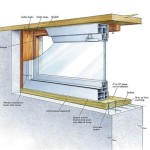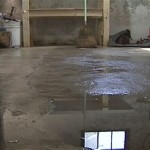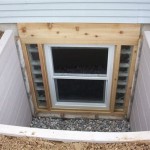How To Fix A Cracked Concrete Basement Floor
Cracks in a concrete basement floor are a common issue in many homes. They can be caused by a variety of factors, including settling, hydrostatic pressure, shrinkage, and temperature fluctuations. While minor cracks might be purely cosmetic, larger cracks can indicate structural issues or allow water and radon to seep into the basement. Addressing these cracks properly is essential for maintaining the integrity and health of the home.
Before attempting any repairs, it's crucial to understand the type of crack present. Hairline cracks, less than 1/16th of an inch wide, are typically caused by concrete shrinkage and are usually not a structural concern. Larger cracks, wider than 1/16th of an inch, may indicate more serious issues and require professional assessment. Horizontal cracks along the wall-floor joint can be a sign of hydrostatic pressure, which requires addressing the underlying water issue before repairing the crack itself.
The repair process for minor cracks differs significantly from major cracks. For hairline cracks, epoxy injection is often the most effective method. This involves cleaning the crack thoroughly with a wire brush and vacuum, then injecting epoxy resin into the crack using a specialized applicator. The epoxy fills the crack, bonding the concrete back together and preventing further expansion.
Repairing larger cracks often requires more extensive work. For cracks wider than ¼ inch, concrete patching compounds are commonly used. This process involves widening the crack slightly with a chisel and hammer to create a V-shaped groove, cleaning the groove thoroughly, and then filling it with the patching compound. It is important to choose a patching compound specifically designed for concrete and to follow the manufacturer's instructions carefully.
For very wide or deep cracks, or cracks that show signs of movement, professional intervention is recommended. A structural engineer can assess the severity of the damage and recommend the appropriate repair strategy. This may involve underpinning, which strengthens the foundation, or other specialized techniques.
Proper preparation is crucial for the success of any concrete crack repair. The area surrounding the crack should be cleaned thoroughly to ensure proper adhesion of the repair material. This involves removing any loose debris, dust, or paint with a wire brush, scraper, or grinder. A vacuum is then used to remove any remaining particles.
Controlling moisture is another essential aspect of crack repair. Before applying any repair material, ensure the concrete is completely dry. Excess moisture can interfere with the bonding process and lead to premature failure of the repair. If the crack is actively leaking, it’s essential to address the source of the water intrusion before attempting any repairs.
After the repair material has cured, it can be painted or sealed to match the surrounding concrete. This not only improves the aesthetics but also provides an additional layer of protection against moisture and further cracking. Choosing a high-quality concrete sealant can help to prevent future water infiltration.
Regular inspection of the basement floor for cracks is an important preventative measure. Early detection and prompt repair can prevent small cracks from becoming larger, more problematic issues. Addressing potential causes of cracking, such as poor drainage or excessive hydrostatic pressure, can also help to minimize the risk of future cracks.
While some minor crack repairs can be undertaken by homeowners with DIY experience, more complex repairs are best left to professionals. Attempting to repair significant structural cracks without the necessary expertise can exacerbate the problem and potentially compromise the structural integrity of the building. Consulting a qualified contractor ensures the repair is performed correctly and effectively.
Understanding the different types of concrete cracks and their underlying causes is crucial for selecting the appropriate repair method. Thorough preparation, proper moisture control, and the use of suitable repair materials are essential for a successful and long-lasting repair. Regular inspection and preventative measures can help to minimize the risk of future cracking and maintain a healthy, structurally sound basement.
Different types of concrete patching and repair materials are available on the market, each with its own advantages and disadvantages. Epoxy-based products are known for their strong bonding properties and resistance to moisture. Polyurethane-based products are flexible and can accommodate minor movement in the concrete. Hydraulic cement is a fast-setting option that is useful for repairing active leaks. Selecting the appropriate material depends on the type and size of the crack, as well as the specific environmental conditions.
Safety precautions should always be observed when working with concrete repair materials. Wear appropriate protective gear, such as gloves, eye protection, and a dust mask, to prevent exposure to dust and chemicals. Ensure adequate ventilation in the work area. Always follow the manufacturer’s instructions and safety guidelines for the specific products being used.

Causes Of Basement Floor Cracks And What To Do About Them News Events For Systems Inc

Foundation Floor Crack Repair Crackx

Concrete Floor Crack Repair Step 1 Exposing Fresh

Cracks In Basement Floor Signs Of Foundation Problems

How To Fix Cracks Crumbles And Breaks In Concrete Dap Global

How To Stop Basement Floor Cracks Groundworks

Concrete Basement Cellar Floor Crack Repair In Worcester Ma

How To Repair Concrete Cracks In A Floor Baileylineroad

What Causes Leaky Floors In Basements Fixing Leaking Basement

How To Fix Cracked Concrete Putting Two Methods The Test Renee Renovates
Related Posts







